Is the servant still inside?
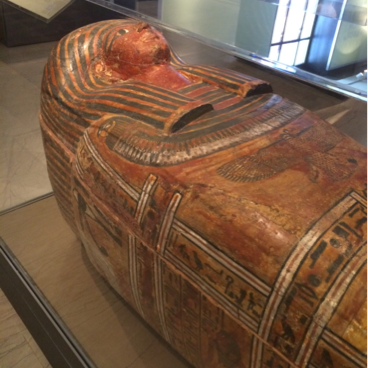
No, Teti's body is now currently in Museum storage.
What I meant to say is: is Teti okay?
Yes, Teti is just fine - he is kept in storage because the temperature and light can be more controlled allowing for better preservation of his remains. It was his wish-as was the wish of many ancient Egyptians-to be mummified when he passed away.
Question: where are the mummy bodies? I see the cases, but not the bodies.
There are currently four mummies in the galleries: Thothrides, Hor, Gautseshenu, and the Anonymous Man. We have some in storage and there are also examples of coffins/cartonnages that have been separated from their mummies before coming to the museum.
Is there a body in this coffin?
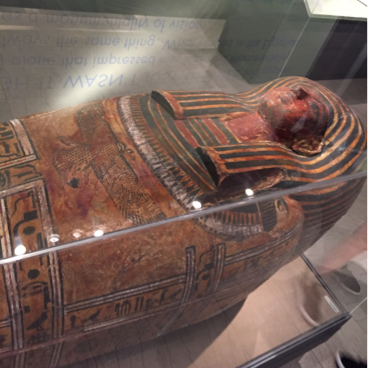
No, although Teti's body was inside when the museum acquired the coffin, his body is now in storage, not inside the coffin in the galleries.
Hi, I'm writing a paper on Teti's coffin and I need some help. Could you tell me what some of the symbols mean?
There is so much to see on it--do you see those two big black dogs on the top? Those are representations of the god Anubis, Anubis was the guardian of mummies and he was responsible for escorting souls to the netherworld.
This looks like an eagle, what does it represent?

That is actually a falcon and falcons represent the god Horus. Horus symbolizes order over chaos.
Thanks! What is this eye for?
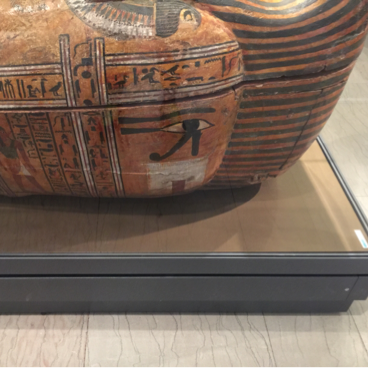
You will see that eye on many of the coffins--it's called a wedjat-eye or the eye of Horus. These eyes were painted on coffins because it was believed they would allow the deceased to see and participate in funerary rituals. They were painted so that when the person was buried they would always face east toward the rising sun.
Wow. What is this bird for?
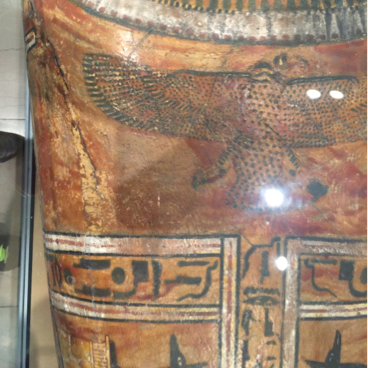
That bird represents the goddess Nekhbet and she spreads her wings across the chest of the deceased to protect the mummy.
Is this Anubis too?
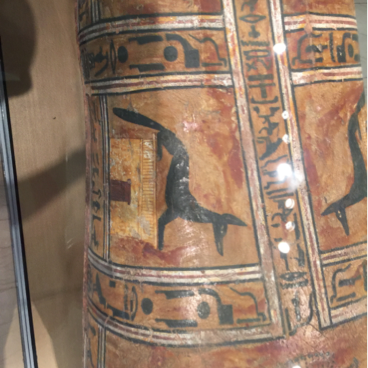
Anubis as the jackal on top of an image of a sarcophagus shows him protecting the body during its journey in the afterlife.
Are there any other coffins like this at Brooklyn that I could look at?
There is a whole mummy chamber in the back of the galleries and on your way there the Coffin of Nespanetjerenpere is a good one to check out.
Do we know who painted Teti's coffin and why it is painted so detailed?
Coffins were very important and they were all created with great care--there were many images and prayers you would want on your coffin to ensure you made it safely to the afterlife. In fact, Teti spent one year's salary on his coffin.
One year's salary? Wow.
Yes--that alone shows you how important it was! I can't think of anything I would spend one year's salary on.
Was anything buried with him?
I don't think we know exactly what Teti was buried with but Ancient Egyptians were usually buried with offerings for use by the deceased in the afterlife.
Can you please tell me more about Teti's coffin.
I can tell you that Teti was an artisan who painted tombs in the Valley of the Kings. He paid nearly a year's salary for this coffin, which is made of wood and has five different colors on it.
One particularly interesting fact is that over time, we see more and more people with elaborately decorated coffins. By the New Kingdom, middle ranks of society were able to afford coffins inscribed with parts of 'The Book of the Dead' inscribed on funerary objects. So here, Teti has on the side of his coffin one of the spells from the Book of the Dead. You'll also see four different figures on the side, let me know when you can see them. They're all to the left of the big Wedjat eye.
So let me tell you about them, you see the one all the way to the left, with the bird's head? That's the god Thoth, with the head of an Ibis bird, he's the god of hieroglyphs, writing, and generally wisdom. After him comes the human-headed god Kebehsenuef, who was one of Horus' sons. Then comes Anubis, the god of mummification. He's the one who would weigh the heart of the person traveling through the underworld. You'll see other jackals, who represent Anubis, at the top of the coffin as well. The last one all the way to the right, is Hapi, another son of Horus, who is associated with the Nile and fertility. All together they are depicted as reciting this spell from 'The Book of the Dead' in order to protect Teti's body.
I actually found the text that they are all saying in the hieroglyphs! Here is what Kebehsenuef is saying:
'I am your son, Osiris, I have come to be your protection
I have united your bones for you, I have assembled your limbs for you
I have brought you your heart, and placed it for you at its place in your body
I have strengthened your house after you, as you live, eternally.' And next to Hapi is written: "I have come to be your protection I have bound your head and your limbs for you I have smitten you enemies beneath you for you, and given you your head, eternally.'
I can tell you that I got some of the information from our website, some from our publication 'To Live Forever' written by our curator Dr. Edward Bleiberg, and the translation of 'The Book of the Dead' from the University College of London website.
Are the zig zags water?
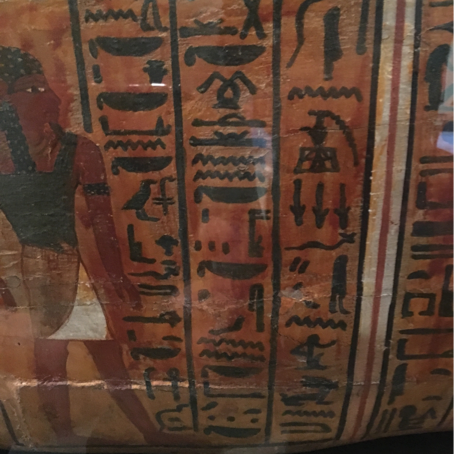
Sometimes! The "zig-zag" is based on a pictogram for water and does sometimes stand for water, but, in this case, they stand for the "n" sound.
Thanks, my 5 year old nephew asked that!
Sure thing, I'm glad he's exploring the galleries! We have a Mummy Chamber on the far side that has a copy of the Book of the Dead that's super cool!
Thank you, working our way over to it now! :)
What does the eye mean?

The Eye of Horus, or the wedjat-eye, symbolizes health, rejuvenation, and prosperity. It shows up a lot in ancient Egyptian art!
What are all these symbols? Where would they get the colors from?
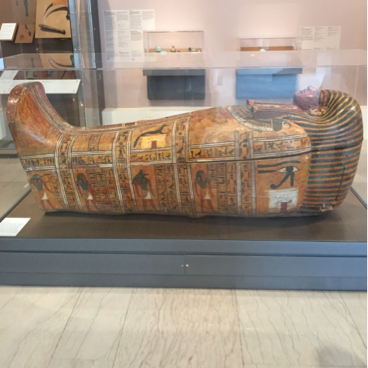
There's a lot of symbolism here. For instance, do you see the eye on the side? Eyes appear on many Egyptian coffins. It's called a wedjat-eye or the eye of Horus. These eyes were painted on coffins because it was believed they would allow the deceased to see and participate in funerary rituals. They were painted so that when the person was buried they would always face east toward the rising sun.
Regarding you question about the colors: They would have used soot for the black, lapis lazuli or azurite for the blue, malachite for the green, and ochres or iron oxide for the reds.
Tell me more.

This coffin, which belongs to Teti, an artisan who worked in the Theban cemeteries, is one of the earliest yellow coffins known to scholars.
When finishing the coffin, a yellow varnish was applied to the whole surface, but areas that were to remain white–eyes, parts of kilts, the shrines on the sides–were carefully avoided.
One detail that I like is that his wig is so heavy it appears to pushes his ears down.
Who was Teti?
Teti is identified as a "Servant of the Great Place," which was the title given to the artists and artisans who worked on the tombs of the Theban cemeteries.
Was it common for artisans to afford such luxurious coffins?
It was not that uncommon. On top of their government salary, many artists also conducted private business selling crafts and services. This is how some were able to afford land, slaves, livestock, and elaborate burials.
Like today, it required budgeting and saving, which not everyone did! Teti likely saved for about a year to afford this coffin. It is also important to remember that the artisans, like Teti, working on tombs and tomb decoration also had direct access to the makers of such luxurious burial goods.
Very cool!
Dime más.
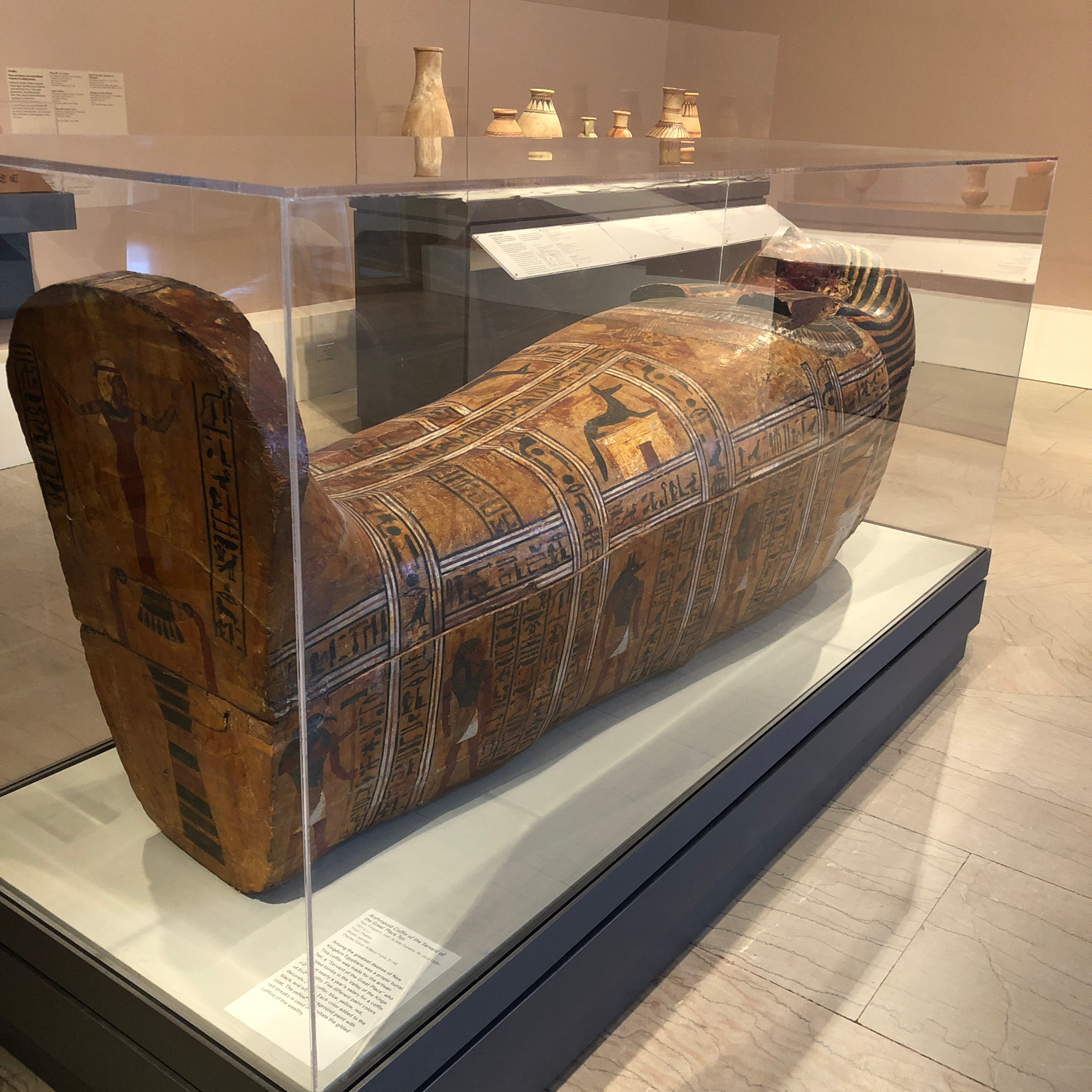
Esta es el ataúd de Teti! Era un artesano que vivo en pueblo Deir-el-Medina. La gente que vivía allí trabajaba en las tumbas de Tebas como el Valle de los Reyes.Puede ser uno de los ejemplos más antiguos de ataúdes amarillos.
¿A qué faraón pertenece?
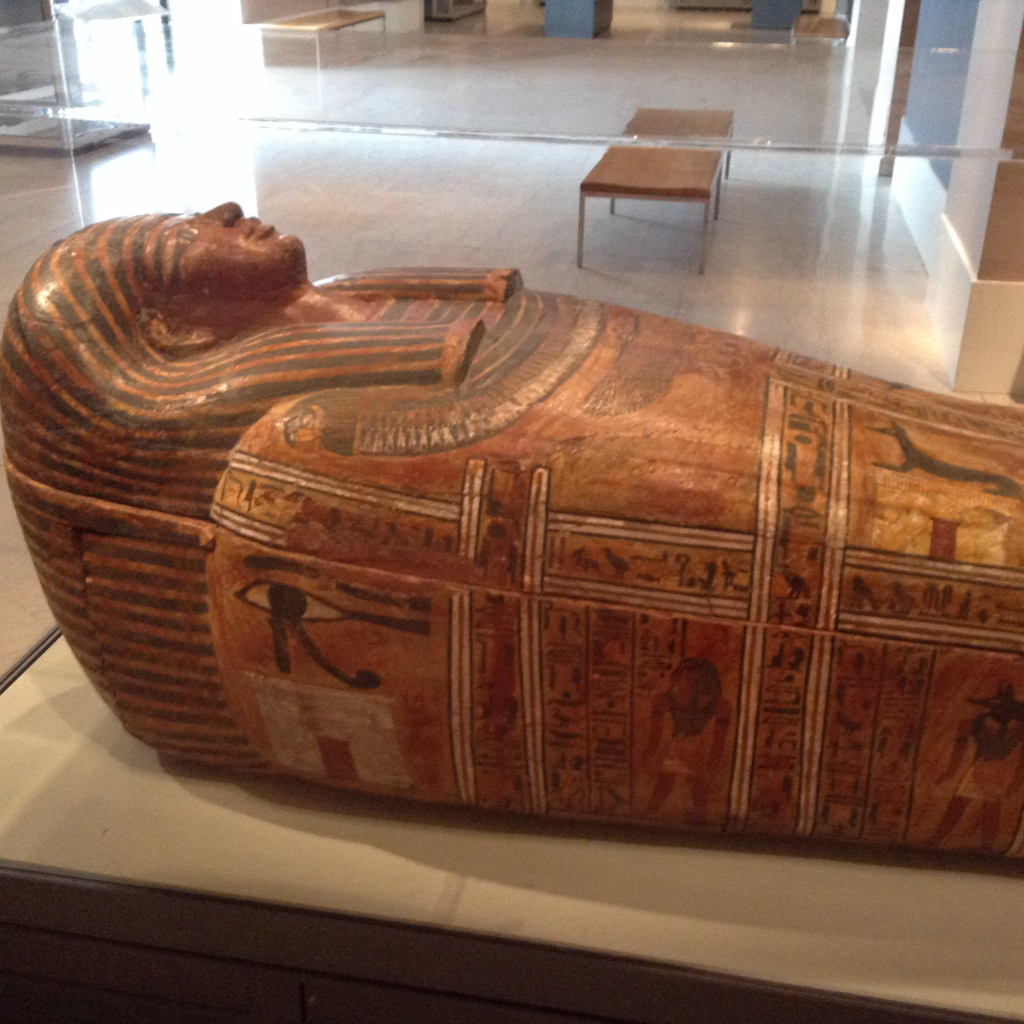
Este ataúd fue hecho para un hombre llamado Teti que vivió en El Lugar de la Verdad, ahora conocido como Deir el-Medina, y trabajó como artista o artesano en los cementerios de Tebas.
Was this coffin found in a pyramid?
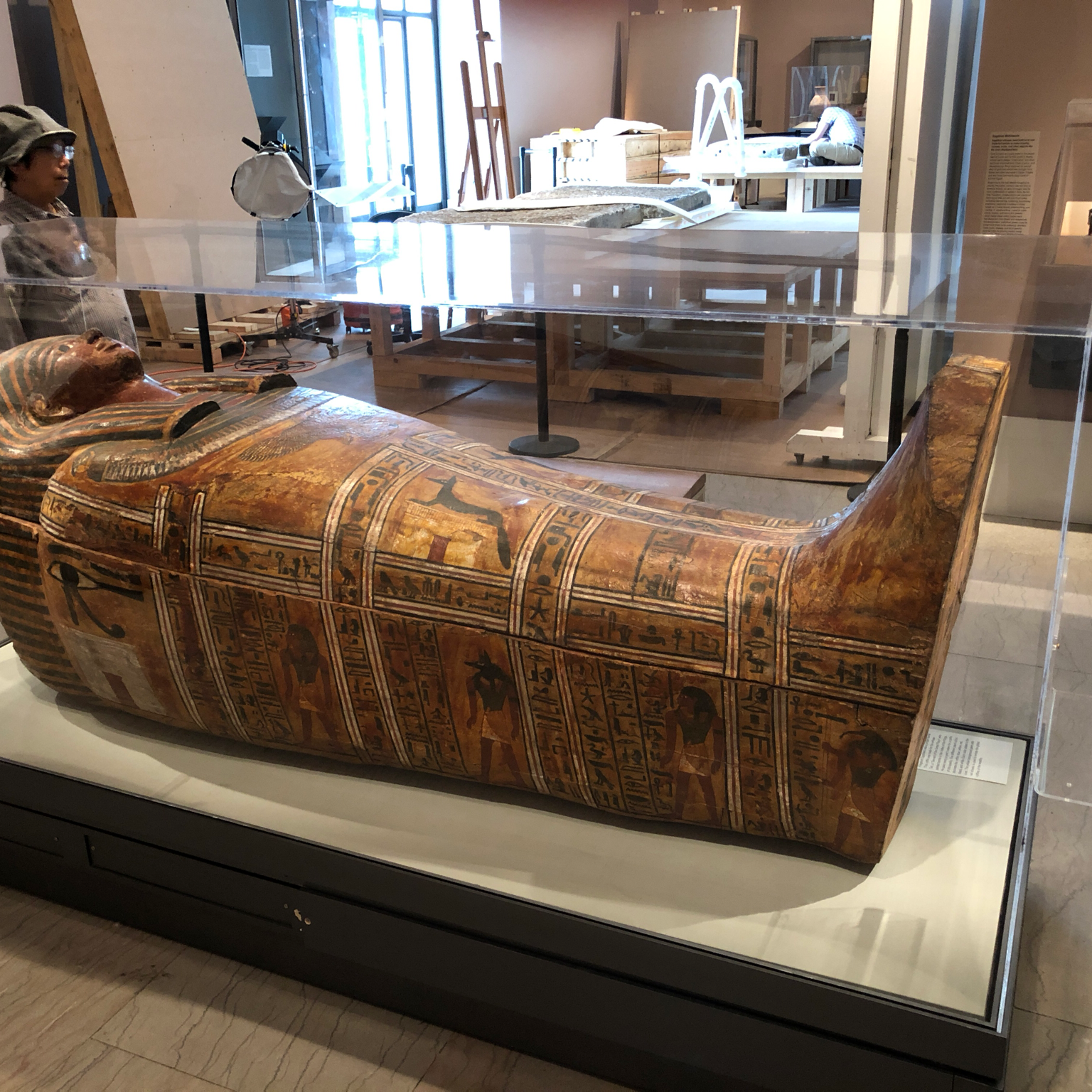
No, the only people who were actually buried in the pyramids were kings and queens. Other elite Egyptians would be buried in nearby cemeteries.
This coffin was actually found in the cemetery of a place called Deir el-Medina not far from the Valley of the Kings. It was a small village where the artists who built and decorated the kings' tombs lived!
Thank you very much.
I am pretty sure that two of the gods on the coffin are Thoth and Anubis, but I do not know the other one.

Thoth and Anubis are definitely on this coffin! Coming up from the feet on Teti's left side (the side you photographed) are Thoth, Qebehsenuef, Anubis, and Hapy.
Qebehsenuef and Hapy are two of the four sons of Horus. The other two, Duamutef, and Imsety, are on the other side of the coffin with repeated images of Thoth and Anubis. The sons of Horus are associated with mummification and the journey to the afterlife.
Anubis is, of course, a god of mummification and the journey to the afterlife as well. Thoth was important on the coffin because he is thought of as all-knowing and an important judge that helps to determine access to the afterlife.
How old is this?
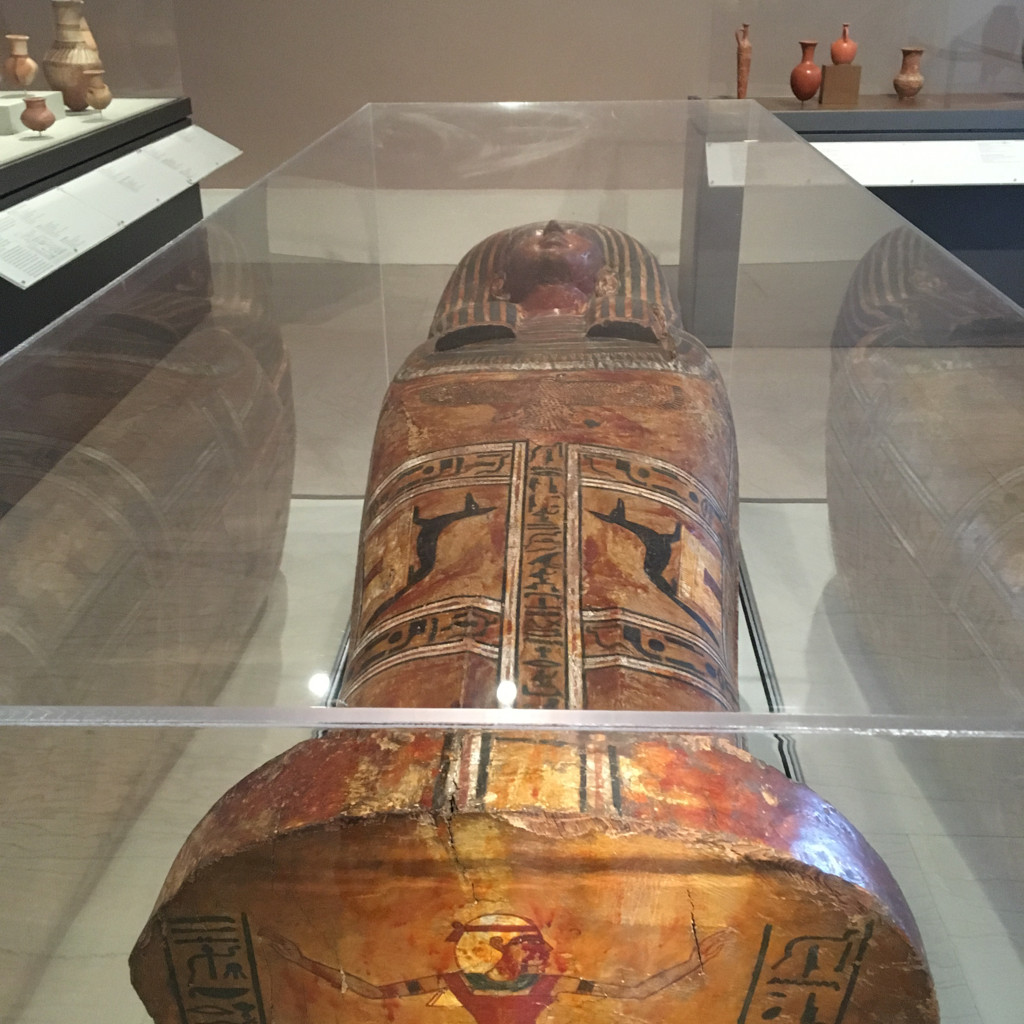
Teti lived around 1339-1307 BCE, so about 3300 years ago.
Where is this from?

This coffin comes from an area near modern Luxor, Egypt known as Dier el-Medina. In ancient times, this area was home to a village of artists and artisans who built and decorated the tombs in the region including the famous Valley of the Kings. This coffin belonged to a man named Teti who would have worked in these tombs.
What's the significance of the design at the bottom?

That's Isis depicted at Teti's foot! This image paris with an image of a Nephthys painted at the top of the head. The two goddesses were sisters and regarded as the archetypal mourners.
Images of them were common in funerary equipment so that they could mourn over the deceased they mourned over the murdered Osiris.
In fact, the hieroglyph you see on the lower portion of the sarcophagus is "djed" which means strength and endurance. It is believed that the form is meant to represent Osiris's spine!
Wow.
Why are some coffins bigger than others? Is it a status thing? Or is it just more money, bigger coffin? Is there a belief that a bigger/grander coffin equals a cushier afterlife?
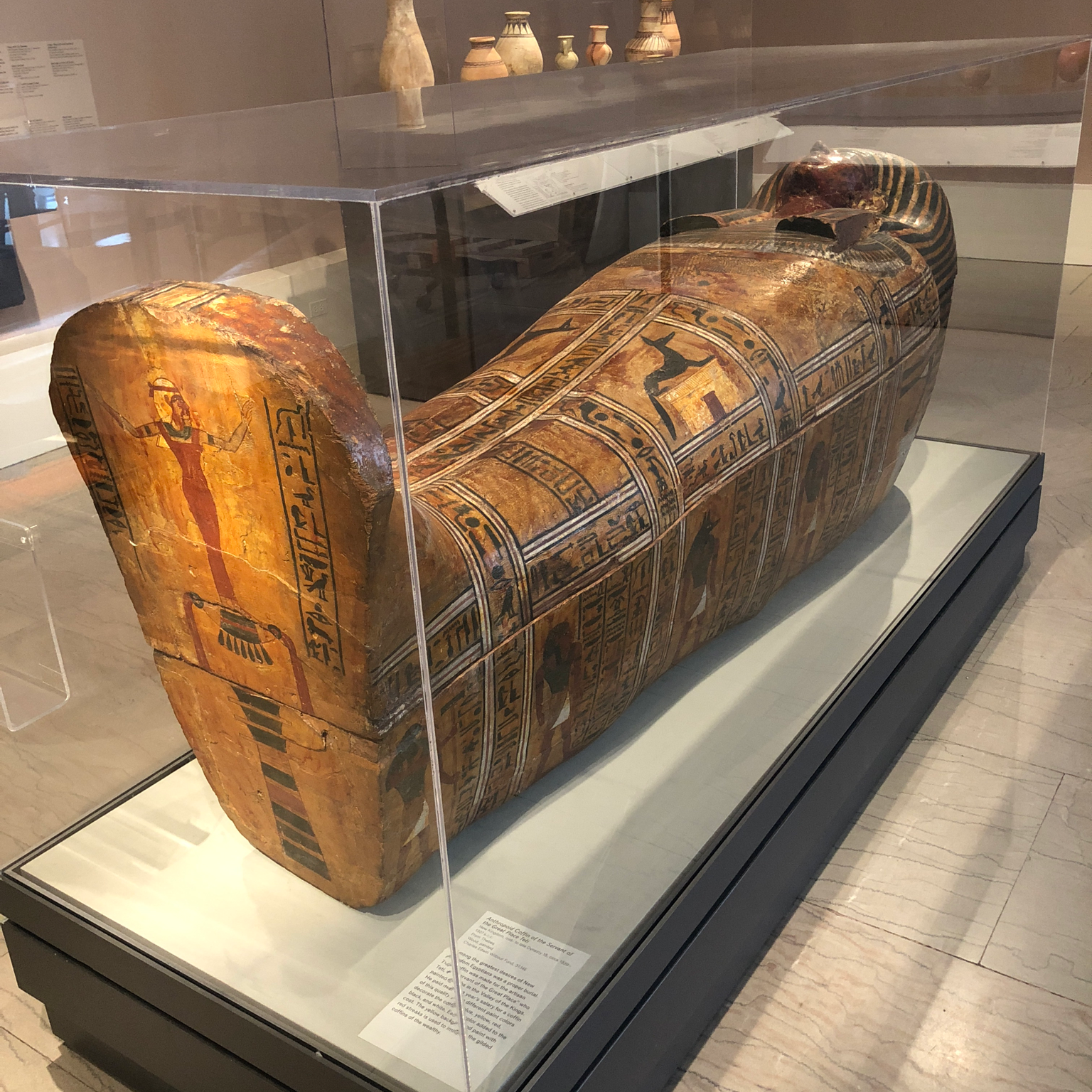
There are a number of factors. Money is, of course, part of it, as well as time period and the type of coffin. Many wealthier Egyptians would have multiple coffins that nested inside one another requiring larger coffins for the outer layers.
This anthropoid---human shaped---coffin may have been Teti’s only coffin or may have been designed to fit inside of a larger rectangular one.
Awesome! Thanks!
Why did they put the eye of Horus all over this sarcophagus?
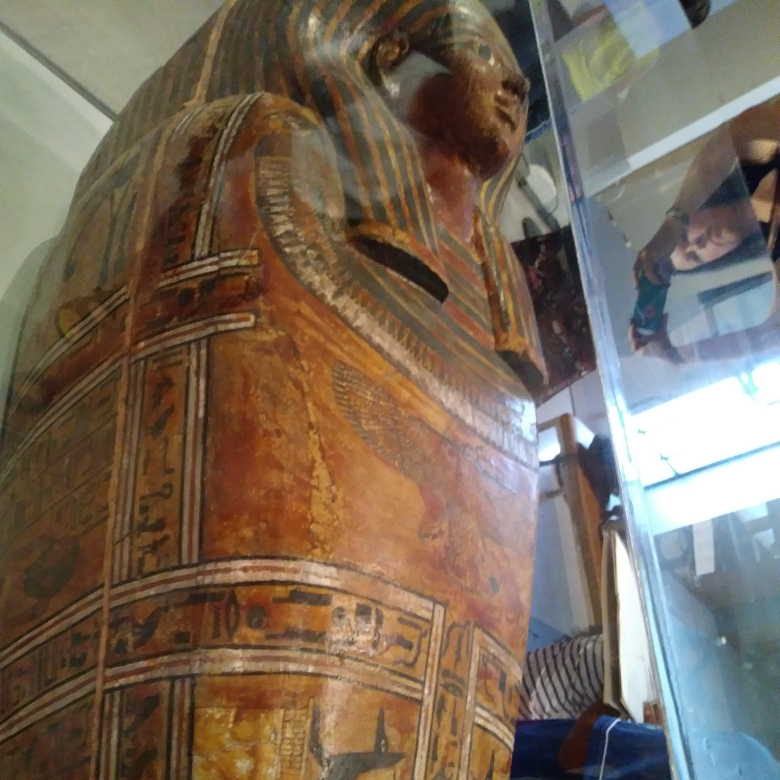
The Eye of Horus was a symbol of protection which was needed for the dangerous and difficult journey to the afterlife. These two large eyes were also thought to allow the person inside the coffin to see out into the world.
Can you tell more about this and what it’s made of?
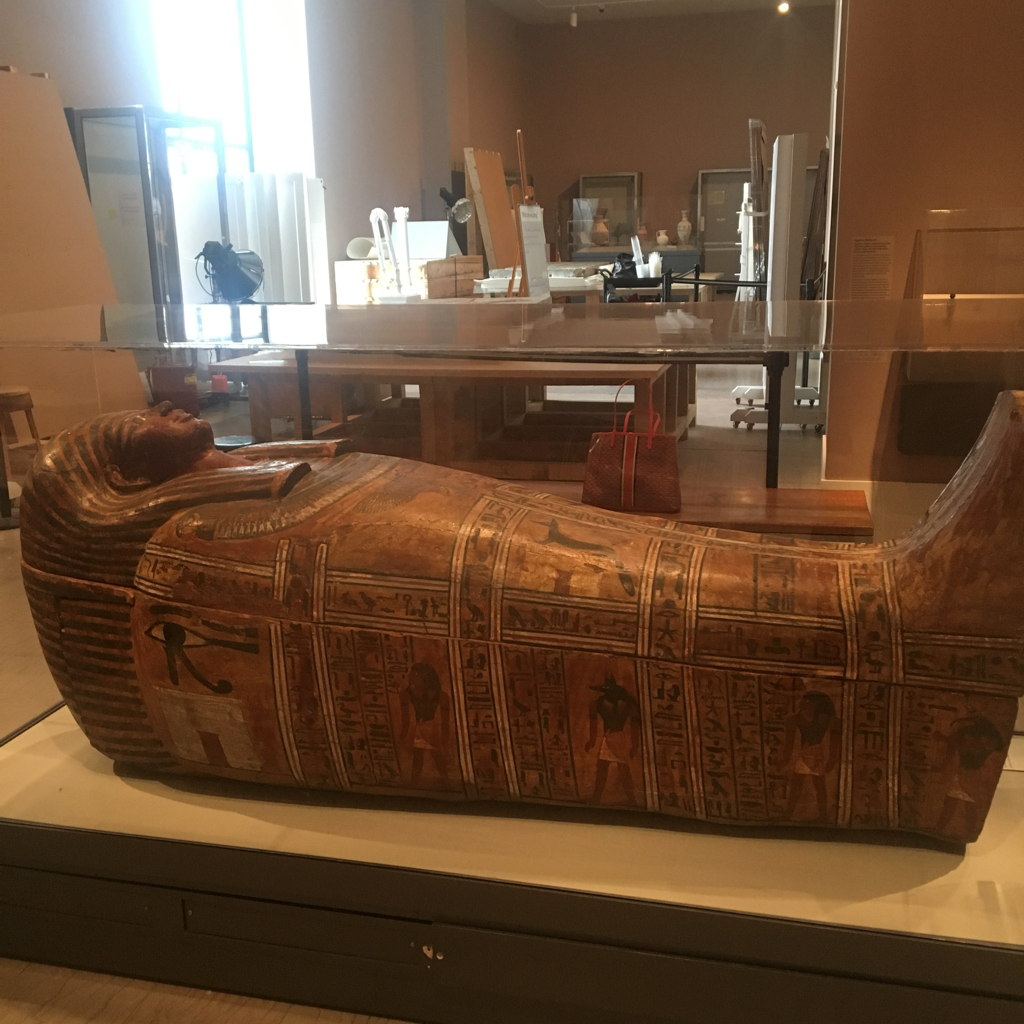
Most simply, the coffin is made of wood. It's considered anthropoid because it is in the shape of a person, with a head, shoulders, and feet.
A thin layer of gesso was used to smooth out the wood for painting. After the decoration was applied, a layer of yellow varnish was applied over the decoration except in areas that were to remain white–like eyes, parts of kilts, and the shrines on the sides–which were carefully avoided.
What does this mummy case signify?
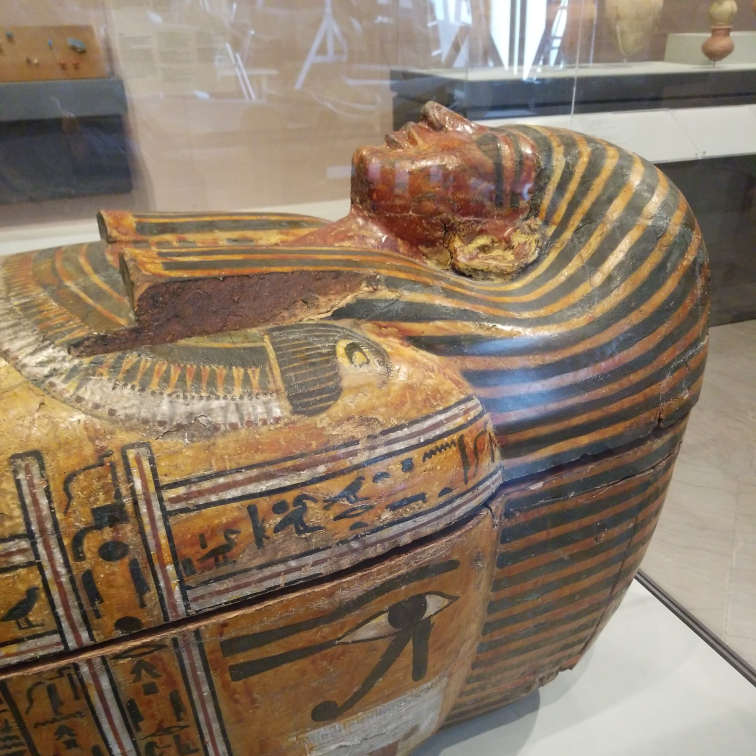
These decorated coffins were one of many ways that the deceased was identified, protected, and transformed for their journey to the afterlife. Something especially significant about this coffin is that it is the earliest yellow coffin known to scholars.
This is interesting because it was made by the same artisans who designed and decorated to the tombs of royalty in the Valley of the Kings and other nearby cemeteries. In fact, Teti, the owner of this coffin, was one of those artisans.
What’s special about it?
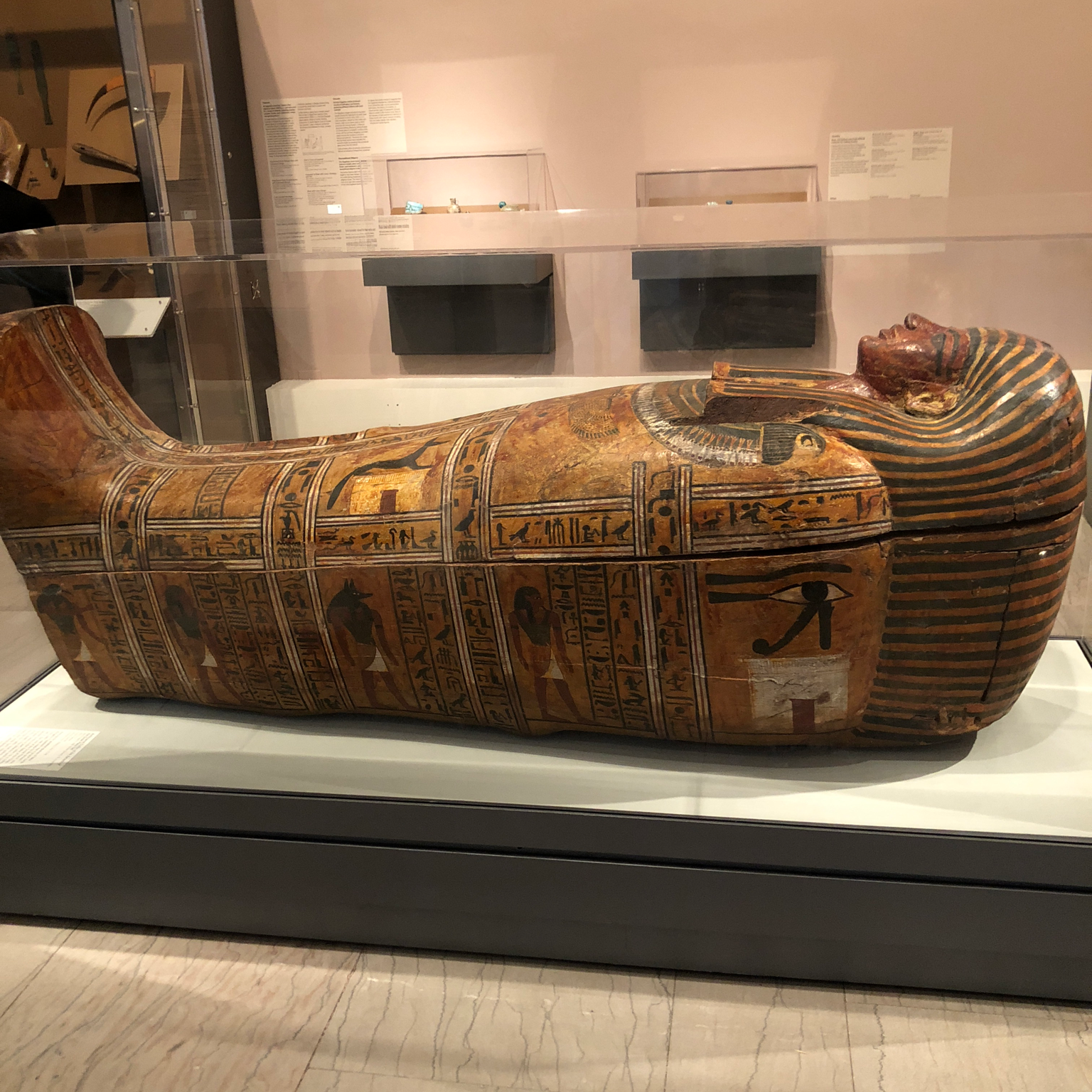
It is one of the earliest examples (maybe even THE earliest example) of a yellow coffin from ancient Egypt. The way that it is decorated more closely resembles black coffins (like that of Kamwese that you can see in the Mummy Chamber) than later yellow coffins (of which there is also an example in the Mummy Chamber.)
Another interesting point is that Teti was not a very wealthy man, he did not have a particularly special title. He saved up a year's salary in order to afford this coffin.



































































